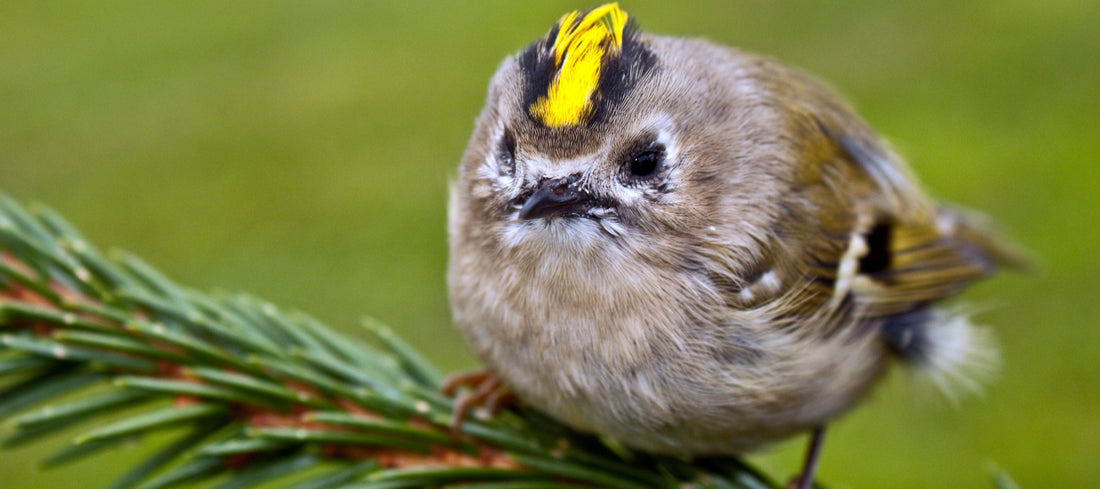The UK’s smallest bird, the Goldcrest (Regulus regulus) can be seen in coniferous woodland, mixed woodland, parks and occasionally gardens. It is a fast-moving bird which can be very difficult to spot. Just 9cm in length and with a wingspan of 14cm, the goldcrest weighs only 5 grams. That’s the same weight as a 20p coin!
This diminutive bird has dull, greyish plumage and a pale belly together with a black and yellow stripe on its head. The stripe of male birds features an orange centre. The goldcrest’s beak is slender, and this enables it to pluck insects from between pine needles. During the autumn and winter, goldcrests join flocks of other small species, roaming in search of food.
What is the goldcrest’s distribution and population?
Goldcrests are found throughout the UK except for in treeless areas on fells and in northern Scotland. Our native birds are sedentary, but UK populations are swelled by migratory birds from Scandinavia each autumn. There are estimated to be around 610, 000 breeding pairs resident in this country. The goldcrest is not of conservation concern but remains vulnerable to future habitat destruction.
How common are goldcrests in UK gardens?
In September, the Garden BirdWatch survey revealed that goldcrests were sighted in 5. 3 per cent of gardens compared to the 20-year average of 3. 5 per cent. Last February the little birds were seen in nearly one in 10 gardens compared to the average of just over 6 per cent. The birds are quite vocal and loud so you may hear them, even if you don't see them! Goldcrests are warblers and are often found in flocks which feed in conifers and yew trees where they create a significant hubbub of high-pitched twittering. It is interesting that these woodland birds are turning to gardens for food and shelter. Without the Garden BirdWatch survey, their behaviour may not have been noted and recognised. It is always worth providing for smaller visitors like the goldcrest. Fat balls provide high energy food for tiny birds which may struggle to survive the coldest weather conditions.
What do goldcrests eat?
This species eats insects, spiders, moth eggs and other small insect food. They feed in tree crowns or towards the ends of branches, often hovering in front of spiders’ webs. Goldcrests won’t visit garden feeders but may take breadcrumbs and cheese from bird tables in the winter when food in their natural habitat is scarce.
How do goldcrests survive in cold weather?
This species survives freezing winter nights by inducing a lower metabolic rate in order to reduce its energy consumption overnight. However, in freezing conditions, the energy economies of induced hypothermia can be insufficient to counter the negative effects of hypothermia. These include the energy required to raise body temperature back to normal at dawn. The birds are able to maintain a more normal body temperatures by metabolising the fat laid down during the day. In addition, two or more birds may roost together for thermal insulation. It isn't difficult to see how important food and shelter are to these tiny birds in periods of harsh weather.
Where do goldcrests nest?
Goldcrests build delicate nests in trees from spider’s web, moss and lichen. Nests are spherical and are usually suspended in twigs. Clutches can feature up to 12 eggs which are incubated for 16 days. Chicks fledge after 18 days. Most pairs will try to rear two overlapping broods each year in the spring. The female can lay the second clutch before her first brood have fledged. The male bird feeds the first brood when the female begins incubating the second.
Did you know?
There was a time when ornithologists didn’t believe that such small birds could cross the North Sea unaided. They thought that goldcrests must be riding on the backs of woodcocks or owls. Hence the traditional name for the goldcrest – woodcock pilot.

